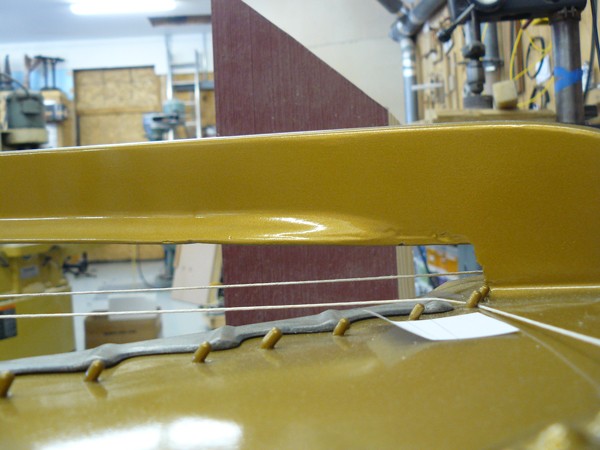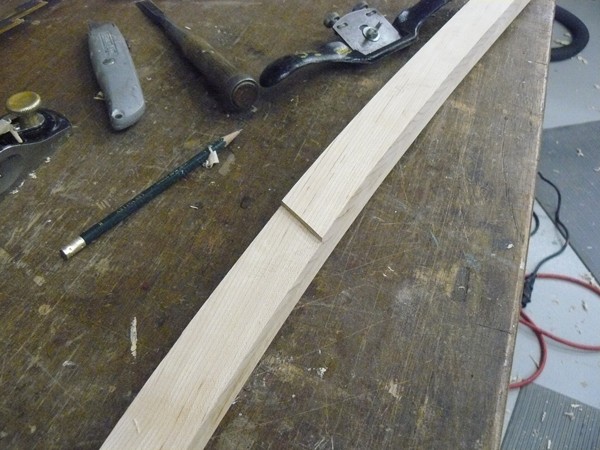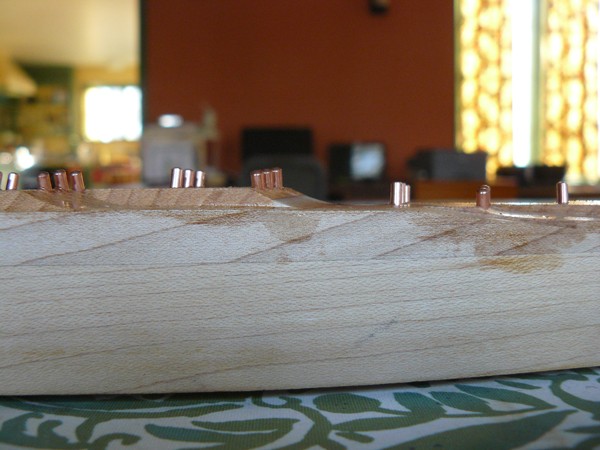<major "purpose" of DB...that being to avoid challenging the bridge pin terminations.
Given their design, they are only marginally structurally adequate when new.
Negative bearing ... takes the marginal nature of the bridge pin termination and challenges it further than it needs to be challenged.
The traditional bridge pin setup, though it seems to avoid tonal issues which many bridge agraffes present, is simply a nail pounded into wood...fairly stone age technology. It works. However, though it works, its ability to work, in the long term, is limited by the condition of the wood and the size of the wood hole it is driven in to. With moisture cycling, or over aggressive lateral termination offset angles, the changeable wood surrounding the pin, enlarges the pin hole and the termination degrades. Some of the side bearing forces, I think, are mitigated by the string being supported by the surface of the cap. So instead, when there is DB, the pins, the wood laterally,and the wood vertically combine to keep the termination efficient. The pin remains the actual termination, with the wood laterally and vertically supporting the pin in its task. Zero to negative bearing, removes the vertical support offered by the surface of the cap, and forces the pins, and the size of the pin hole to do all the work. Given how easy it is to enlarge a hole with a nail driven into it, and given how picky the termination requirements are, this creates a scenario where the long term survival of the termination is challenged.
DB is probably more of a safety factor than a structural factor.
This is, at least in my take, described above. DB, since the string is pressing down into the cap, takes some of the tendency of the string to work the pin laterally in RH changes, and reduces that tendency, thus offering the pin and pin hole, another vector of support. Zero to neg DB removes that added support vector. That's the safety factor.
The structural factor assumes DB is necessary for tonal function of the soundboard structure. This model assumes the board must be pre-loaded by the DB in order to function. Paullelo and Stuart have challenged that assumption by eliminating the pins as a lossy termination, and removing all or most bearing.
In the example I gave, where, without either my fix or Ed's fix, that region would have been placed 1/8" south of zero bearing, would place serious stress on the pin terminations, and thus the apparent life of the either the system, or parts of the scale. .
Not only would this scenario remove the vertical support of the cap from the pin termination, at neg DB, especially gross negative DB, the strings would be actively pulling up and side-wise, on the pin.
Re DB and [loading], the board needs structure.
A board without structure will flap in the breeze. How much structure is another question, and somewhat dependent on aesthetic tonal choices. Inadequate internal structure to the board,.results in conditions where individual notes can be, with serious voicing time, made to sound reasonable. However, when the structure is inadequate, the board cannot differentiate more than one note at a time. The more-than-one-note texture becomes muddy, explosive and incapable of amplitude variation. DB is, as far as I can tell in my work, not part of the structure of the board. I can't go to the mat on this one, as it is simply relaying my observations up to this point. However, in my work, I am thinking these days, about DB as a termination requirement, and not as a structural one. I have thus backed it off to the point where I find termination suffers...that is, at this writing(subject to revision, constantly) 1deg@88, reducing to 0.3 bottom of the long bridge, and as close to just slightly positive on the bass bridge as possible.
Beyond its termination function, I'm currently finding higher bearing to be choking the board more than anything else useful. As to Keith's point about smooth graduations of DB being not that important, he could be right about that. From my perspective, the only way for me to know whether that is correct of not, is to be capable of creating a piano where I can control the as-built DB curve. This is easier said than done...quite challenging, to control the DB curve in this way, but without actually doing it, and then not doing it, one really can't tell whether even graduation of DB is an important factor or not. I'm in the trying to observe the condition accurately phase..and its a hard phase to pull of practically speaking.
------------------------------
Jim Ialeggio
grandpianosolutions.com
Shirley, MA
978 425-9026
------------------------------
Original Message:
Sent: 02-13-2018 23:28
From: David Skolnik
Subject: Interesting Downbearing Observation
Jim -
With regret, I feel like each one of your comments warrants some expansion. Clearly, I lack any semblance of imagination:
major "purpose" of DB...that being to avoid challenging the bridge pin terminations.
Given their design, they are only marginally structurally adequate when new.
Negative bearing ... takes the marginal nature of the bridge pin termination and challenges it further than it needs to be challenged.
Many "soundboard" jobs are actually bridge termination jobs.
DB is probably more of a safety factor than a structural factor.
In the example I gave, where, without either my fix or Ed's fix, that region would have been placed 1/8" south of zero bearing, would place serious stress on the pin terminations, and thus the apparent life of the either the system, or parts of the scale. .
Re DB and [loading], the board needs structure.
DB and deflection are to my mind, mainly indications of the structure currently present in the board. I use them as indicators not as primary causal factors.
------------------------------
David Skolnik
Hastings-on-Hudson NY
914-231-7565
Original Message:
Sent: 02-13-2018 14:04
From: Jim Ialeggio
Subject: Interesting Downbearing Observation
Keith, you didn't mention what is perhaps the major "purpose" of DB...that being to avoid challenging the bridge pin terminations. Given their design, they are only marginally structurally adequate when new. Negative bearing, while the board itself, in some circumstances, may still be functional, takes the marginal nature of the bridge pin termination and challenges it further than it needs to be challenged. Many, certainly not all, but many "soundboard" jobs, are actually bridge termination jobs. DB is probably more of a safety factor than a structural factor.
In the example I gave, where, without either my fix or Ed's fix, that region would have been placed 1/8" south of zero bearing, would place serious stress on the pin terminations, and thus the apparent life of the either the system, or parts of the scale. .
Re DB and laoding, the board needs structure. How much is, I think dependent on the tonal aesthetic one prefers...and there are, multiple viiable tonal aesthetic of piano tone. DB and deflection are to my mind, mainly indications of the structure currently present in the board. I use them as indicators not as primary causal factors.
------------------------------
Jim Ialeggio
grandpianosolutions.com
Shirley, MA
978 425-9026
Original Message:
Sent: 02-13-2018 01:03
From: Keith Akins
Subject: Interesting Downbearing Observation
I've just delivered a Kawai GS-50 with weird DB setup. In that case I didn't replace board or bridges -- just the pinblock, so I had to work with what was there. There are substantial stretches of zero or negative bearing. I did my best and the pianist (head of the piano department at a university school of music home piano) is happy. This reinforces an opinion I have been coming to. It may be completely erroneous but here it is:
Because of empirical experience, I no longer believe that regular transitions of downbearing is necessary -- or even relevant, at least in some situations. Rather, I think the issue is soundboard loading. I think for any given soundboard there is an appropriate zone of total load. Downbearing serves to achieve that load. As long as the board is loaded into that zone, things will work out.
Soundboard deflection is correlative to loading -- but the issue is loading, not deflection. i.e., deflection can indicate amount of loading (or whether any loading occurs at all or not) but is not in and of itself the determinative factor to good SB function. Bearing is a "once-removed indicator of deflection and a twice-removed indicator of loading.
In the case of the Kawai mentioned above, since it was an old board (well ~35 years or so -- at least middle-aged) it did not need as much loading as a new board would. The plate was setup in a truly bizarre fashion and we did a good bit of plate grinding and substituting individual rests for the aliquot bars. (It wasn't an issue of soundboard collapse-- even if the board/bridge was higher it would have been erratic.) What we did was apparently enough -- the piano sounds better than when we got it in and I'm quite sure better than when it was new from the factory.
Well, that's my story and i'm stickin' to it ....
;-)
------------------------------
Keith Akins
Akins Pianocraft
Menominee MI
715-775-0022
Original Message:
Sent: 02-12-2018 21:25
From: Jim Ialeggio
Subject: Interesting Downbearing Observation
I will pay attention to at pitch strung conditions in this area, and see if there is in fact anomalous plate defined lack of bearing here, or whether it was accommodated some other way.
------------------------------
Jim Ialeggio
grandpianosolutions.com
Shirley, MA
978 425-9026
Original Message:
Sent: 02-12-2018 21:15
From: Edward McMorrow
Subject: Interesting Downbearing Observation
My solution is to grind and shim rests as needed to get the smooth and proper progression of increasing bridge heights from bass to treble that are the Steinway "norm".
I just completed a 1960's NY D that had a 3-4mm difference between the bottom of the lowest metal duplex string rest and the felted rest on the low tenor. I fitted bridge pins to elevate and support the low end of the shimmed duplex rest and ground away on the shelf below to even the elevations. I also pinned the duplex plate rests to the plate to keep them from wandering.
I have seen a few original Steinways with a step in the bridge level between string sections, but no more than 1mm or so.
------------------------------
Edward McMorrow
Edmonds WA
425-299-3431
Original Message:
Sent: 02-12-2018 20:52
From: Jim Ialeggio
Subject: Interesting Downbearing Observation
S&S A1 turn of the century. I have developed a protocol which allows me to know and prove where the deflected board is going to end up, before I glue down the board or set the height of the bridge. So, while running the protocol, I looked at my spread sheet and see that there is an approx 1/8" jump in bridge height between note 38 and 39...say what?
First thing was to doubt my calculations. I checked them and rechecked them, and they were spot on. Checked my loaded deflections, and they were spot on. Say what...then I looked carefully at the plate.
Then looked at the old cap...no step, just a gradual change in the height as it progressed through this area. Never made this kind of a sudden height change before...some minor ones, but not like this. 

I still worried about it, after having cecked my proofs, but the protocol, deflection dimensions and calcs were right on. Strung and at pitch it gave smooth progression of DB as measured with a digital angle gauge.
Without some accommodation here, there can not be any bearing in this area, to the tune of 1/8" shy on zero bearing...pretty major non-bearing condition, I think. I have been paying close attention to these "no win" areas, previous to this, especially note #21-26 on concert grands,. The shape of the counterbearing casting on C's and D's makes it pretty difficult, to get even close to reasonable DB, without giving close attention to "gotcha's" defined by the plate.
------------------------------
Jim Ialeggio
grandpianosolutions.com
Shirley, MA
978 425-9026
------------------------------